Modeling In-Vehicle VOCs Distribution from Cabin Interior Surfaces under Solar Radiation
Abstract
1. Introduction
2. Numerical Development and Verification
2.1. The Turbulence Models
2.2. The Radiation Models
2.3. The Solar Load Model (SLM)
2.4. Contaminants Emission Model
2.5. Model Validation and Discussion
3. In-Vehicle VOCs Distribution Considering Solar Radiation
3.1. Vehicle Computational Model
3.2. Boundary Conditions
3.2.1. The Thermal Environment Analysis
3.2.2. The Thermal Setup
3.2.3. The Radiation Setup
3.2.4. The Emission Model Setup
4. Results and Discussion
5. Conclusions
Author Contributions
Funding
Conflicts of Interest
Nomenclature
| Radiation heat flux | |
| Absorption coefficient | |
| Scattering coefficient | |
| Linear-anisotropic phase function coefficient | |
| Incident radiation | |
| Stefan–Boltzmann constant, | |
| Energy flux leaving the surface | |
| Incoming energy flux on the surface | |
| Surface emissivity | |
| Surface reflectivity | |
| Gas local temperature, K | |
| Surface temperature, K | |
| Radiation intensity | |
| Position vector | |
| Direction vector | |
| Scattering direction vector | |
| Refractive index | |
| Phase function | |
| Solid angle | |
| Emission rate | |
| Diffusion coefficient | |
| Initial emittable concentration | |
| Material thickness, mm | |
| Emission time, s | |
| Contaminant quality | |
| Surface area, | |
| Release start time | |
| Release end time | |
| Temperature error | |
| Simulated temperature of the point, K | |
| Measured temperature of the point, K | |
| Thermal conductivity, | |
| Specific heat, | |
| Material Density, | |
| Convective heat transfer coefficient, | |
| Wind speed, | |
| Air density, | |
| Scalar | |
| Molecular diffusivity, |
References
- Tong, Z.; Li, Y.; Westerdahl, D.; Adamkiewicz, G.; Spengler, J.D. Exploring the effects of ventilation practices in mitigating in-vehicle exposure to traffic-related air pollutants in China. Environ. Int. 2019, 127, 773–784. [Google Scholar] [CrossRef] [PubMed]
- Tong, Z.; Li, Y.; Westerdahl, D.; Freeman, R.B. The impact of air filtration units on primary school students’ indoor exposure to particulate matter in China. Environ. Pollut. 2020, 115107. [Google Scholar] [CrossRef]
- Tong, Z.; Whitlow, T.H.; MacRae, P.F.; Landers, A.J.; Harada, Y. Quantifying the effect of vegetation on near-road air quality using brief campaigns. Environ Pollut 2015, 201, 141–149. [Google Scholar] [CrossRef]
- Tong, Z.; Chen, Y.; Malkawi, A.; Adamkiewicz, G.; Spengler, J.D. Quantifying the impact of traffic-related air pollution on the indoor air quality of a naturally ventilated building. Environ. Int. 2016, 89, 138–146. [Google Scholar] [CrossRef]
- Zhang, G.; Li, T.; Luo, M.; Liu, J.; Liu, Z.; Bai, Y. Air pollution in the microenvironment of parked new cars. Build. Environ. 2008, 43, 315–319. [Google Scholar] [CrossRef]
- Brodzik, K.; Faber, J.; Łomankiewicz, D.; Gołda-Kopek, A. In-vehicle VOCs composition of unconditioned, newly produced cars. J. Environ. Sci. 2014, 26, 1052–1061. [Google Scholar] [CrossRef]
- You, K.; Ge, Y.; Hu, B.; Ning, Z.; Zhao, S.; Zhang, Y.; Xie, P. Measurement of in-vehicle volatile organic compounds under static conditions. J. Environ. Sci. 2007, 19, 1208–1213. [Google Scholar] [CrossRef]
- Khanchi, A.; Hebbern, C.A.; Zhu, J.; Cakmak, S. Exposure to volatile organic compounds and associated health risks in windsor, Canada. Atmos. Environ. 2015, 120, 152–159. [Google Scholar] [CrossRef]
- Borecki, M.; Prus, P.; Korwin-Pawlowski, M.L. Capillary Sensor with Disposable Optrode for Diesel Fuel Quality Testing. Sensors 2019, 19, 1980. [Google Scholar] [CrossRef]
- Zulauf, N.; Dröge, J.; Klingelhöfer, D.; Braun, M.; Oremek, G.M.; Groneberg, D.A. Indoor Air Pollution in Cars: An Update on Novel Insights. Int. J. Environ. Res. Public Health 2019, 16, 2441. [Google Scholar] [CrossRef]
- World Health Organization. WHO Guidelines for Indoor Air Quality: Selected Pollutants. Available online: https://www.euro.who.int/_data/assets/pdf_file/0009/128169/e94535.pdf (accessed on 30 June 2020).
- Xu, B.; Wu, Y.; Yu, G.; Wu, S.; Wu, X.; Zhu, S.; Tao, L. Investigation of volatile organic compounds exposure inside vehicle cabins in China. Atmos. Pollut. Res. 2016, 7, 215–220. [Google Scholar] [CrossRef]
- Faber, J.; Brodzik, K.; Da-Kopek, A.G.; Lomankiewicz, D. Benzene, toluene and xylenes levels in new and used vehicles of the same model. J. Environ. Sci. 2013, 25, 2324–2330. [Google Scholar] [CrossRef]
- Yang, X.; Srebric, J.; Li, X.; He, G. Performance of three air distribution systems in VOC removal from an area source. Build. Environ. 2004, 39, 1289–1299. [Google Scholar] [CrossRef]
- Kim, K.-H.; Szulejko, J.E.; Jo, H.-J.; Lee, M.-H.; Kim, Y.-H.; Kwon, E.; Ma, C.-J.; Kumar, P. Measurements of major VOCs released into the closed cabin environment of different automobiles under various engine and ventilation scenarios. Environ. Pollut. 2016, 215, 340–346. [Google Scholar] [CrossRef] [PubMed]
- Cao, X.; Yao, Z.; Shen, X.; Yu, Y.; Xi, J. On-road emission characteristics of VOCs from light-duty gasoline vehicles in Beijing, China. Atmos. Environ. 2015, 124, 146–155. [Google Scholar] [CrossRef]
- Wiglusz, R.; Sitko, E.; Nikel, G.; Jarnuszkiewicz, I.; Igielska, B. The effect of temperature on the emission of formaldehyde and volatile organic compounds (VOCs) from laminate flooring—Case study. Build. Environ. 2002, 37, 41–44. [Google Scholar] [CrossRef]
- Xiong, J.; Zhang, Y. Impact of temperature on the initial emittable concentration of formaldehyde in building materials: Experimental observation. Indoor Air 2010, 20, 523–529. [Google Scholar] [CrossRef] [PubMed]
- Xiong, J.; Zhang, P.; Huang, S.; Zhang, Y. Comprehensive influence of environmental factors on the emission rate of formaldehyde and VOCs in building materials: Correlation development and exposure assessment. Environ. Res. 2016, 151, 734–741. [Google Scholar] [CrossRef]
- Yoshida, T.; Matsunaga, I. A case study on identification of airborne organic compounds and time courses of their concentrations in the cabin of a new car for private use. Environ. Int. 2006, 32, 58–79. [Google Scholar] [CrossRef]
- Geiss, O.; Tirendi, S.; Barrero-Moreno, J.; Kotzias, D. Investigation of volatile organic compounds and phthalates present in the cabin air of used private cars. Environ. Int. 2009, 35, 1188–1195. [Google Scholar] [CrossRef]
- Faber, J.; Brodzik, K.; Łomankiewicz, D.; Gołda-Kopek, A.; Nowak, J.; Świątek, A. Temperature influence on air quality inside cabin of conditioned car. Siln. Spalinowe 2012, 51, 49–56. [Google Scholar]
- Chen, X.; Feng, L.; Luo, H.; Cheng, H. Analyses on influencing factors of airborne VOC S pollution in taxi cabins. Environ. Sci. Pollut. Res. 2014, 21, 12868–12882. [Google Scholar] [CrossRef] [PubMed]
- Xiong, J.; Yang, T.; Tan, J.; Li, L.; Ge, Y. Characterization of VOC emission from materials in vehicular environment at varied temperatures: Correlation development and validation. PLoS ONE 2015, 10, e0140081. [Google Scholar] [CrossRef] [PubMed]
- Huang, W.; Lv, M.; Yang, X. Long-term volatile organic compound emission rates in a new electric vehicle: Influence of temperature and vehicle age. Build. Environ. 2020, 168, 106465. [Google Scholar] [CrossRef]
- Tong, Z.; Liu, H.; Tong, S.; Xu, J. Inverse Design for Thermal Environment and Energy Consumption of Vehicular Cabins with PSO–CFD Method. In International Conference on Man-Machine-Environment System Engineering; Springer Singapore: Singapore, 2020. [Google Scholar]
- Tong, Z.; Li, Y. Real-Time Reconstruction of Contaminant Dispersion from Sparse Sensor Observations with Gappy POD Method. Energies 2020, 13, 1956. [Google Scholar] [CrossRef]
- Chen, Y.; Tong, Z.; Zheng, Y.; Samuelson, H.; Norford, L. Transfer learning with deep neural networks for model predictive control of HVAC and natural ventilation in smart buildings. J. Clean Prod. 2020, 254, 119866. [Google Scholar] [CrossRef]
- Wu, J.; Jiang, F.; Song, H.; Liu, C.; Lu, B. Analysis and validation of transient thermal model for automobile cabin. Appl. Therm. Eng. 2017, 122, 91–102. [Google Scholar] [CrossRef]
- Lee, J.W.; Jang, E.Y.; Lee, S.H.; Ryou, H.S.; Choi, S.; Kim, Y.; Brodzik, K. Influence of the spectral solar radiation on the air flow and temperature distributions in a passenger compartment. Int. J. Therm. Sci. 2014, 75, 36–44. [Google Scholar] [CrossRef]
- Mao, Y.; Wang, J.; Li, J. Experimental and numerical study of air flow and temperature variations in an electric vehicle cabin during cooling and heating. Appl. Therm. Eng. 2018, 137, 356–367. [Google Scholar] [CrossRef]
- Torregrosa-Jaime, B.; Bjurling, F.; Corberán, J.M.; Di Sciullo, F.; Payá, J. Transient thermal model of a vehicle’s cabin validated under variable ambient conditions. Appl. Therm. Eng. 2015, 75, 45–53. [Google Scholar] [CrossRef]
- Zhang, H.; Dai, L.; Xu, G.; Li, Y.; Chen, W.; Tao, W.-Q. Studies of air-flow and temperature fields inside a passenger compartment for improving thermal comfort and saving energy. Part I: Test/numerical model and validation. Appl. Therm. Eng. 2009, 29, 2022–2027. [Google Scholar] [CrossRef]
- Moon, J.H.; Jin, W.L.; Chan, H.J.; Lee, S.H. Thermal comfort analysis in a passenger compartment considering the solar radiation effect. Int. J. Therm. Sci. 2016, 107, 77–88. [Google Scholar] [CrossRef]
- Zhou, X.; Lai, D.; Chen, Q. Experimental investigation of thermal comfort in a passenger car under driving conditions. Build. Environ. 2019, 149, 109–119. [Google Scholar] [CrossRef]
- Marcos, D.; Pino, F.J.; Bordons, C.; Guerra, J.J. The development and validation of a thermal model for the cabin of a vehicle. Appl. Therm. Eng. 2014, 66, 646–656. [Google Scholar] [CrossRef]
- Grundstein, A.; Meentemeyer, V.; Dowd, J. Maximum vehicle cabin temperatures under different meteorological conditions. Int. J. Biometeorol. 2009, 53, 255–261. [Google Scholar] [CrossRef] [PubMed]
- Pan, H.; Qi, L.; Zhang, X.; Zhang, Z.; Salman, W.; Yuan, Y.; Wang, C. A portable renewable solar energy-powered cooling system based on wireless power transfer for a vehicle cabin. Appl. Energy 2017, 195, 334–343. [Google Scholar] [CrossRef]
- Soulios, V.; Loonen, R.; Metavitsiadis, V.; Hensen, J. Computational performance analysis of overheating mitigation measures in parked vehicles. Appl. Energy 2018, 231, 635–644. [Google Scholar] [CrossRef]
- Al-Kayiem, H.H.; Sidik, M.F.B.M.; Munusammy, Y.R.A.L. Study on the Thermal Accumulation and Distribution Inside a Parked Car Cabin. Am. J. Appl. Sci. 2010, 7, 784–789. [Google Scholar] [CrossRef]
- Borecki, M.; Gȩca, M.; Duk, M.; Korwin-Pawlowski, M.L. Miniature gas sensors heads and gas sensing devices for environmental working conditions—A review. J. Electron. Commun. Eng. Res. 2017, 1, 1–11. [Google Scholar]
- Zhai, Z.J.; Zhang, Z.; Zhang, W.; Chen, Q.Y. Evaluation of various turbulence models in predicting airflow and turbulence in enclosed environments by CFD: Part 1–Summary of prevalent turbulence models. Hvac&R Res. 2007, 13, 853–870. [Google Scholar]
- Hussain, S.; Oosthuizen, P.H.; Kalendar, A. Evaluation of various turbulence models for the prediction of the airflow and temperature distributions in atria. Energy Build. 2011, 43, 18–28. [Google Scholar] [CrossRef]
- Li, X.; Tu, J. Evaluation of the eddy viscosity turbulence models for the simulation of convection–radiation coupled heat transfer in indoor environment. Energy Build. 2019, 184, 8–18. [Google Scholar] [CrossRef]
- ASHRAE Handbook-Fundamentals (SI Edition). American society of Heating, Refrigerating and Air-Conditioning Engineers: Atlanta, GA, USA, 2009. Available online: http://shop.iccsafe.org/media/wysiwyg/material/8950P217-toc.pdf (accessed on 7 July 2020).
- Xiong, J.; Wei, W.; Huang, S.; Zhang, Y. Association between the emission rate and temperature for chemical pollutants in building materials: General correlation and understanding. Environ. Sci. Technol. 2013, 47, 8540–8547. [Google Scholar] [CrossRef]
- Huang, S.; Xiong, J.; Zhang, Y. Impact of temperature on the ratio of initial emittable concentration to total concentration for formaldehyde in building materials: Theoretical correlation and validation. Environ. Sci. Technol. 2015, 49, 1537–1544. [Google Scholar] [CrossRef] [PubMed]
- Deng, Q.; Yang, X.; Zhang, J. Study on a new correlation between diffusion coefficient and temperature in porous building materials. Atmos. Environ. 2009, 43, 2080–2083. [Google Scholar] [CrossRef]
- Li, D.F.; Xia, X.L.; Sun, C. Experimental investigation of transient thermal behavior of an airship under different solar radiation and airflow conditions. Adv. Space Res. 2014, 53, 862–869. [Google Scholar] [CrossRef]
- Zhang, Z.; Zhang, W.; Zhai, Z.J.; Chen, Q.Y. Evaluation of various turbulence models in predicting airflow and turbulence in enclosed environments by CFD: Part 2—Comparison with experimental data from literature. Hvac& R Res. 2007, 13, 871–886. [Google Scholar]
- Li, X.; Yan, Y.; Tu, J. Effects of surface radiation on gaseous contaminants emission and dispersion in indoor environment—A numerical study. Int. J. Heat Mass Transf. 2019, 131, 854–862. [Google Scholar] [CrossRef]
- Yang, T.; Zhang, P.; Xu, B.; Xiong, J. Predicting VOC emissions from materials in vehicle cabins: Determination of the key parameters and the influence of environmental factors. Int. J. Heat Mass Transf. 2017, 110, 671–679. [Google Scholar] [CrossRef]
- Kim, K.W.; Lee, B.H.; Kim, S.; Kim, H.J.; Yun, J.H.; Yoo, S.E.; Sohn, J.R. Reduction of VOC emission from natural flours filled biodegradable bio-composites for automobile interior. J. Hazard Mater. 2011, 187, 37–43. [Google Scholar] [CrossRef]
- Qian, K.; Zhang, Y.; Little, J.C.; Wang, X. Dimensionless correlations to predict VOC emissions from dry building materials. Atmos. Environ. 2007, 41, 352–359. [Google Scholar] [CrossRef]
- ANSYS®. Academic Research Release 17.2, Help System, Coupled Field Analysis Guide; ANSYS, Inc.: Canonsburg, PA, USA, 2017. [Google Scholar]
- Lahimer, A.; Alghoul, M.; Sopian, K.; Khrit, N. Potential of solar reflective cover on regulating the car cabin conditions and fuel consumption. Appl. Therm. Eng. 2018, 143, 59–71. [Google Scholar] [CrossRef]
- Mezrhab, A.; Bouzidi, M. Computation of thermal comfort inside a passenger car compartment. Appl. Therm. Eng. 2006, 26, 1697–1704. [Google Scholar] [CrossRef]
- Liang, B.; Yu, X.; Mi, H.; Liu, D.; Huang, Q.; Tian, M. Health risk assessment and source apportionment of VOCs inside new vehicle cabins: A case study from Chongqing, China. Atmos. Pollut. Res. 2019, 10, 1677–1684. [Google Scholar] [CrossRef]
- Wu, W.; Yoon, N.; Tong, Z.; Chen, Y.; Lv, Y.; Ærenlund, T.; Benner, J. Diffuse ceiling ventilation for buildings: A review of fundamental theories and research methodologies. J. Clean Prod. 2019, 211, 1600–1619. [Google Scholar] [CrossRef]

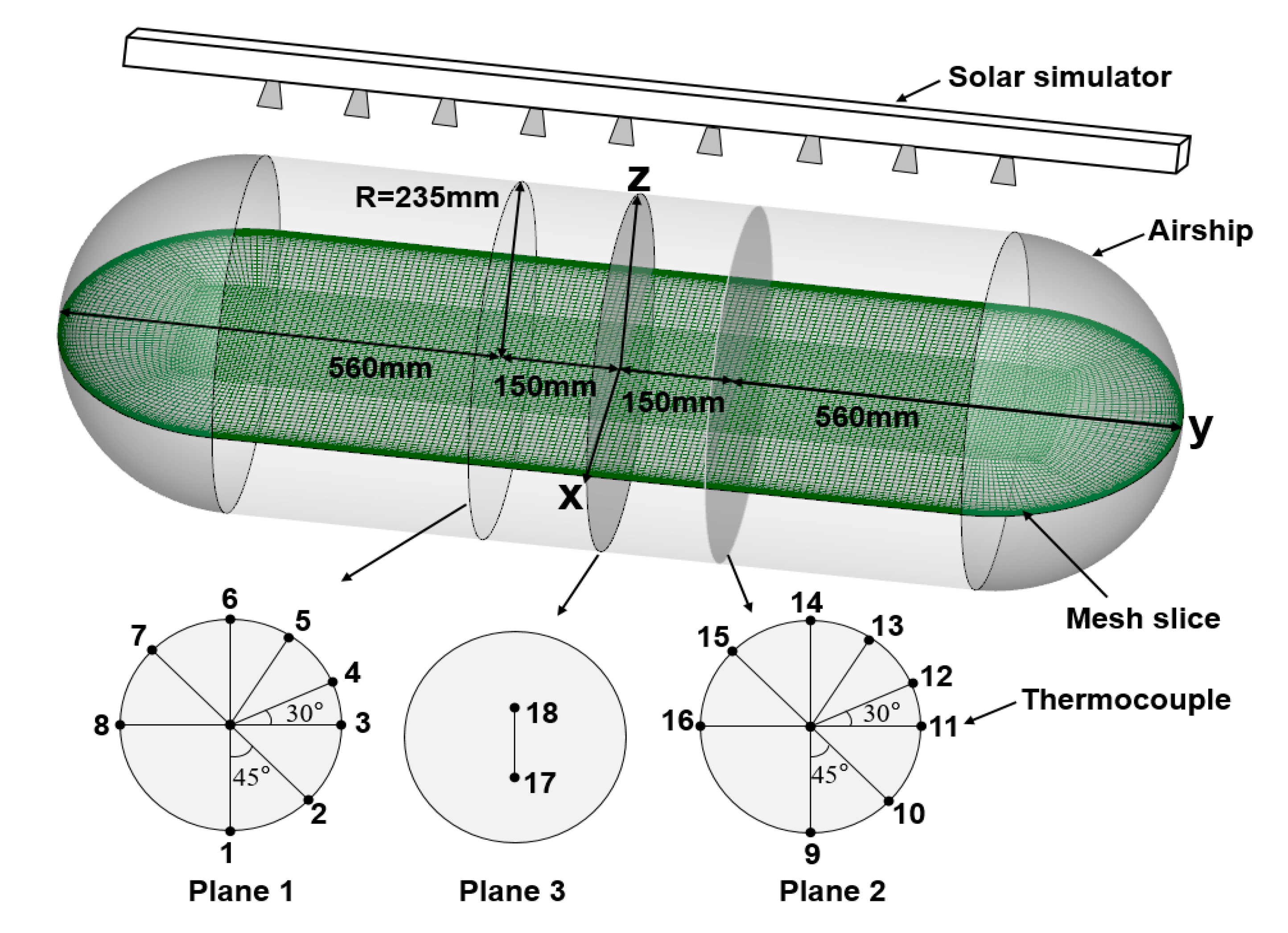
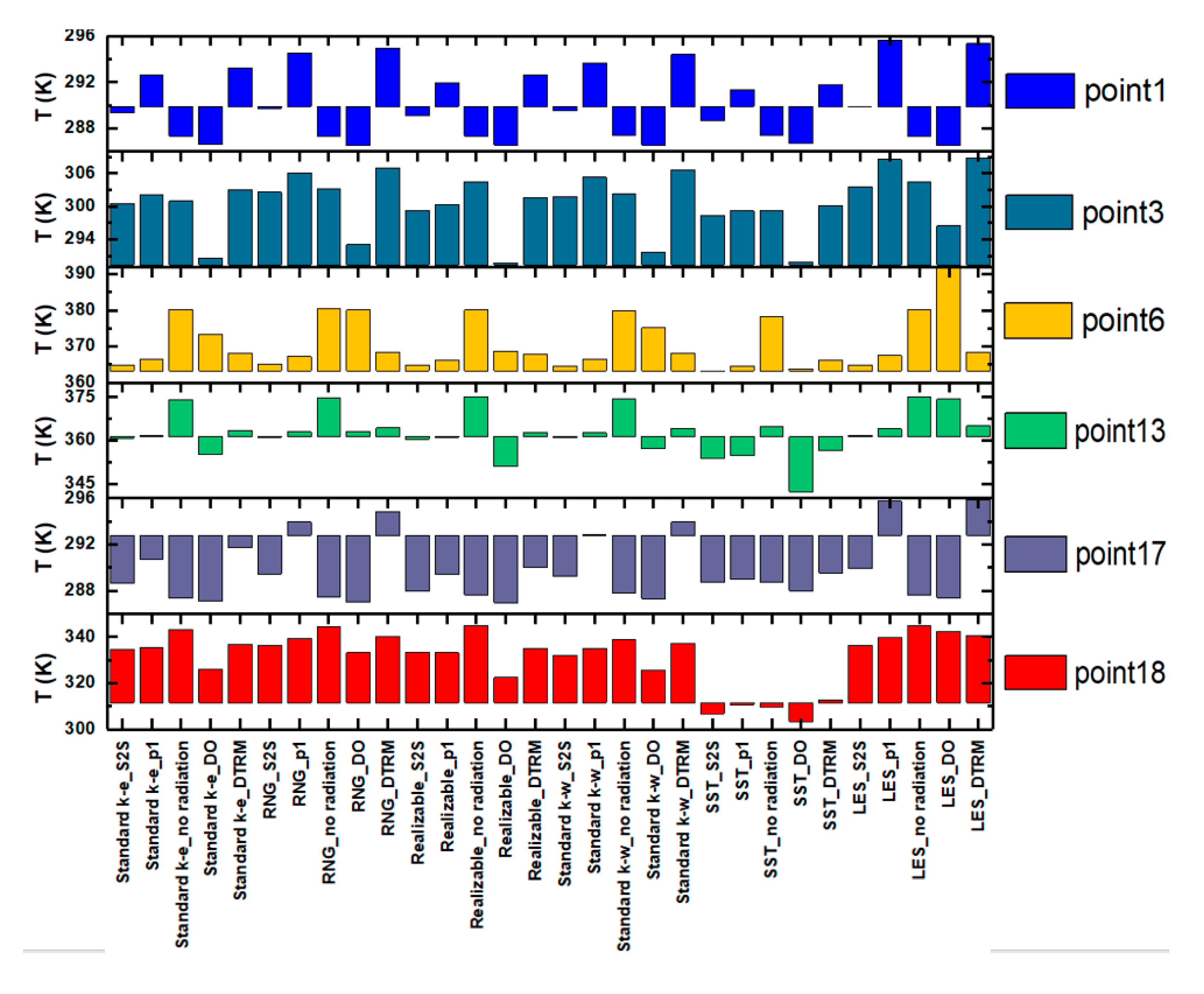
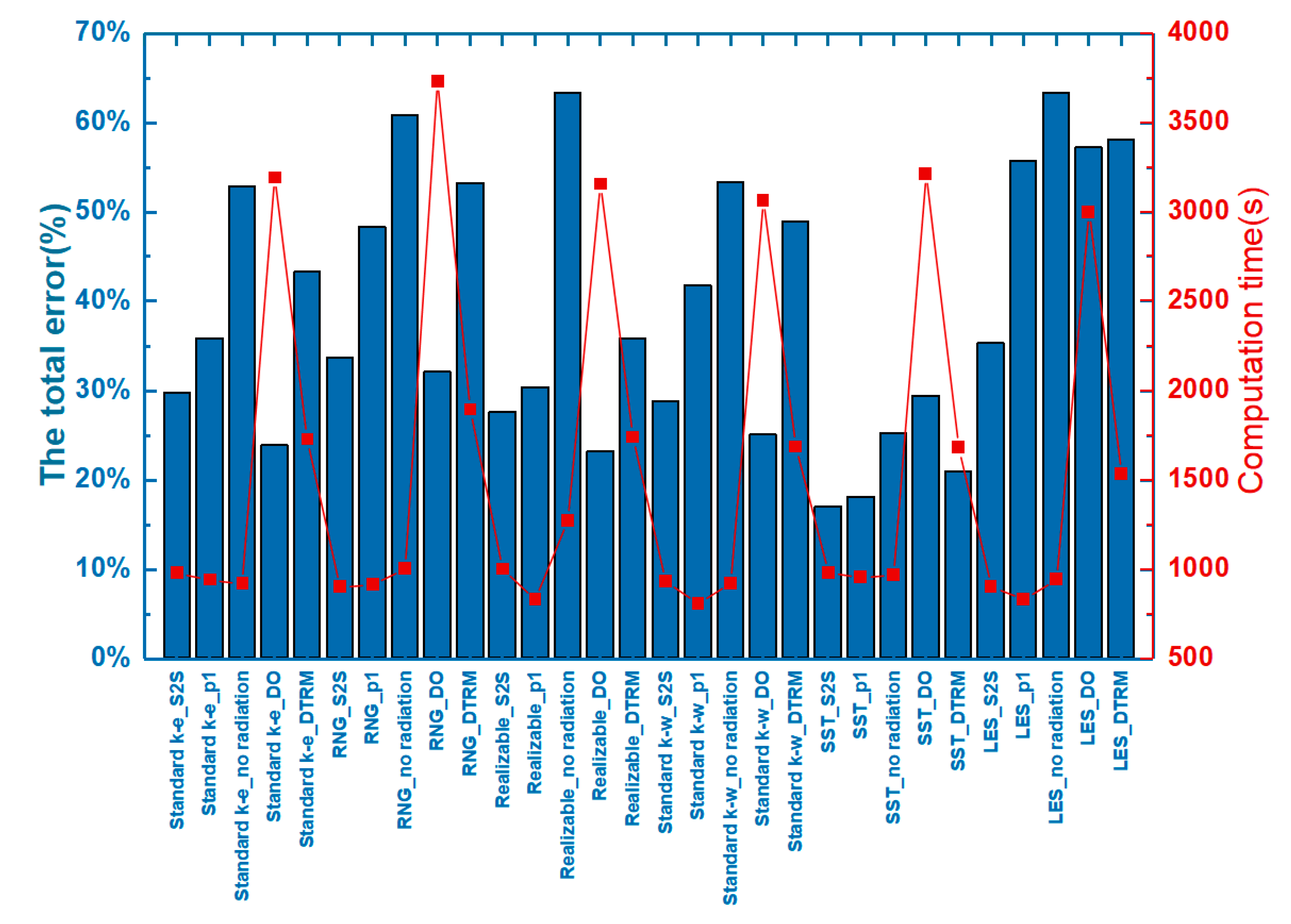
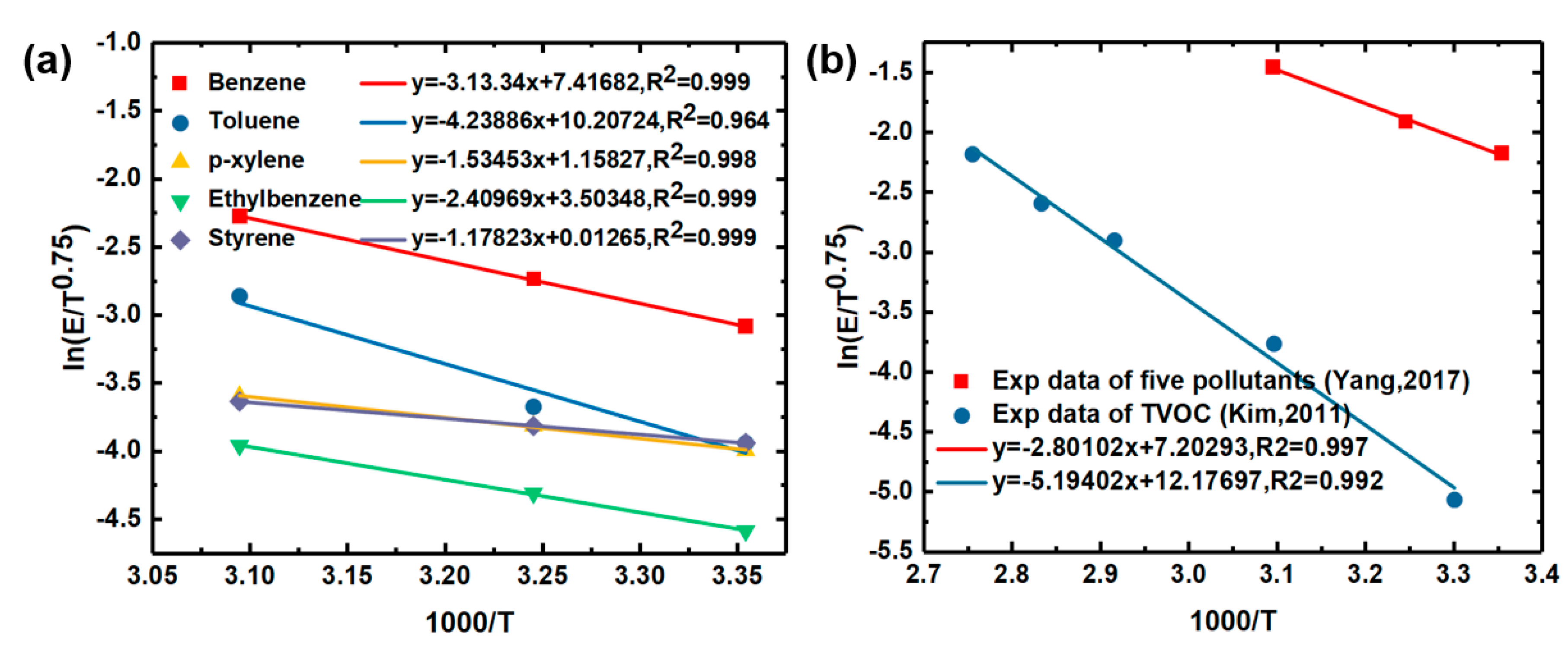
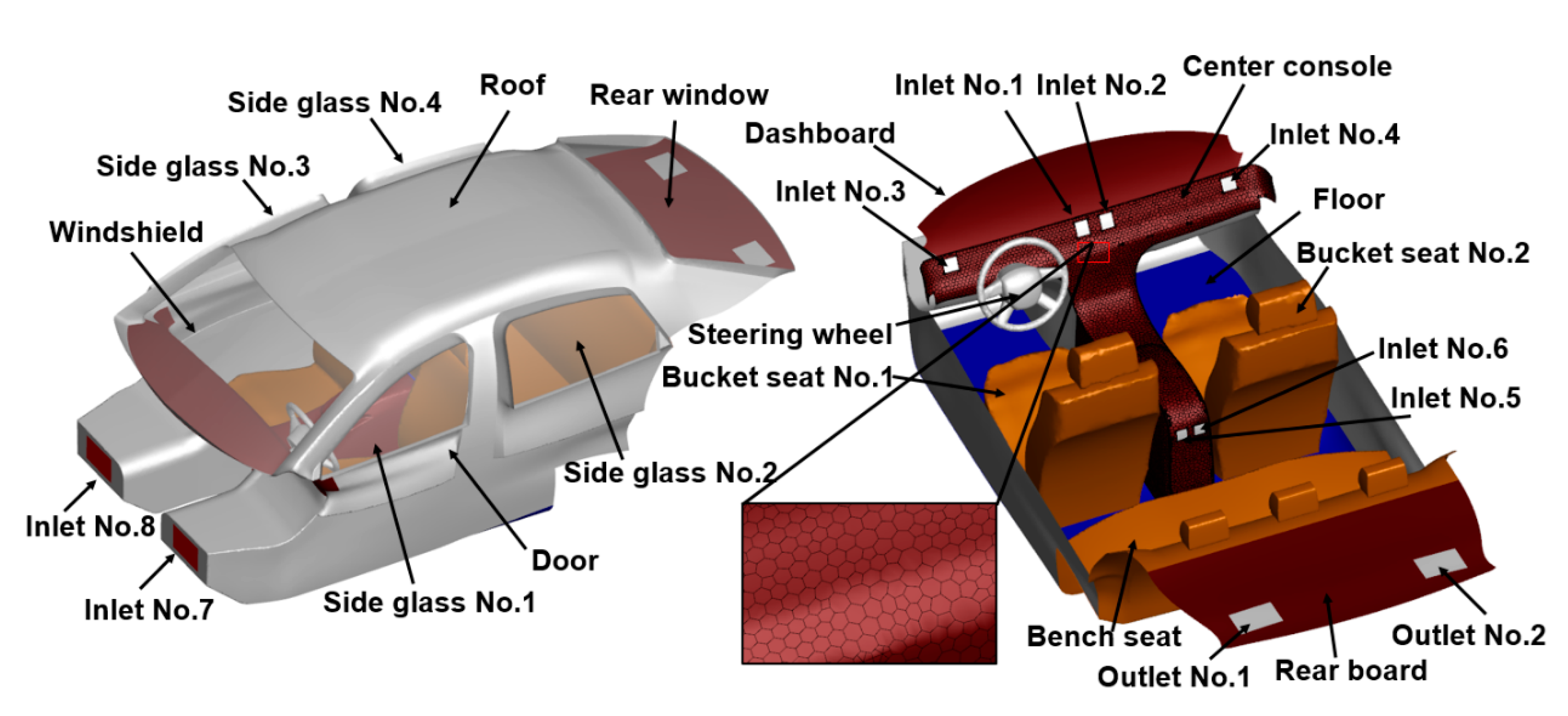
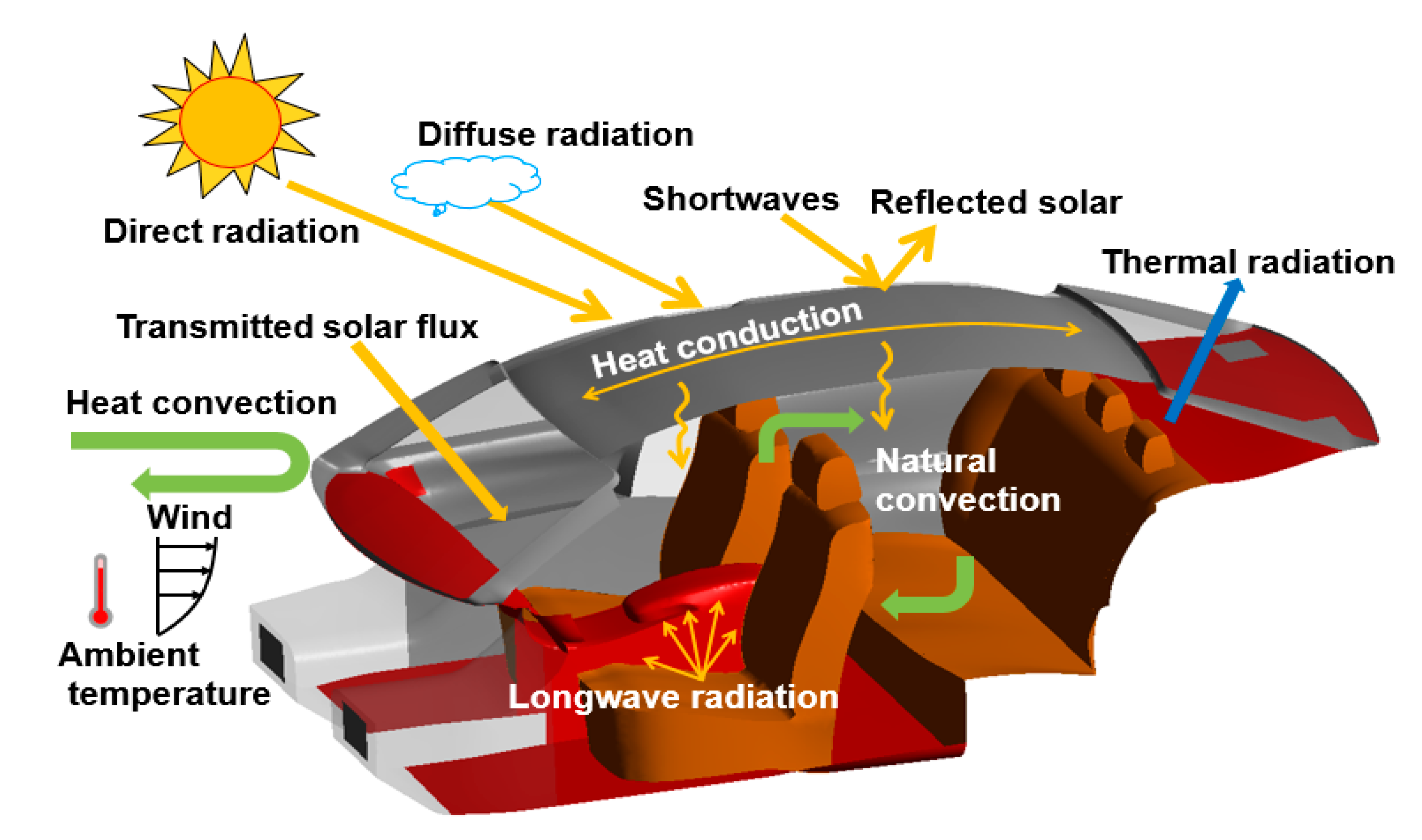

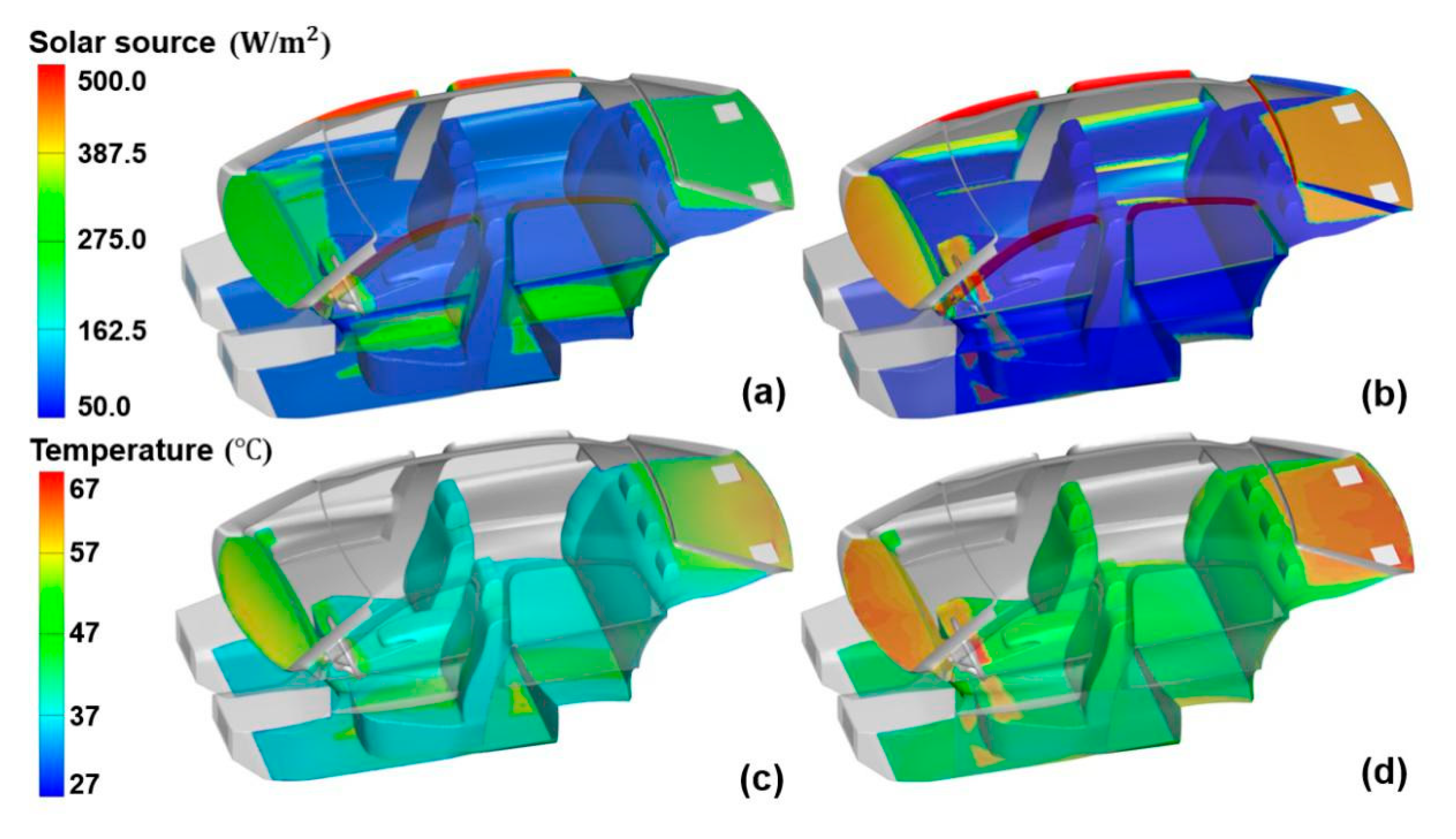
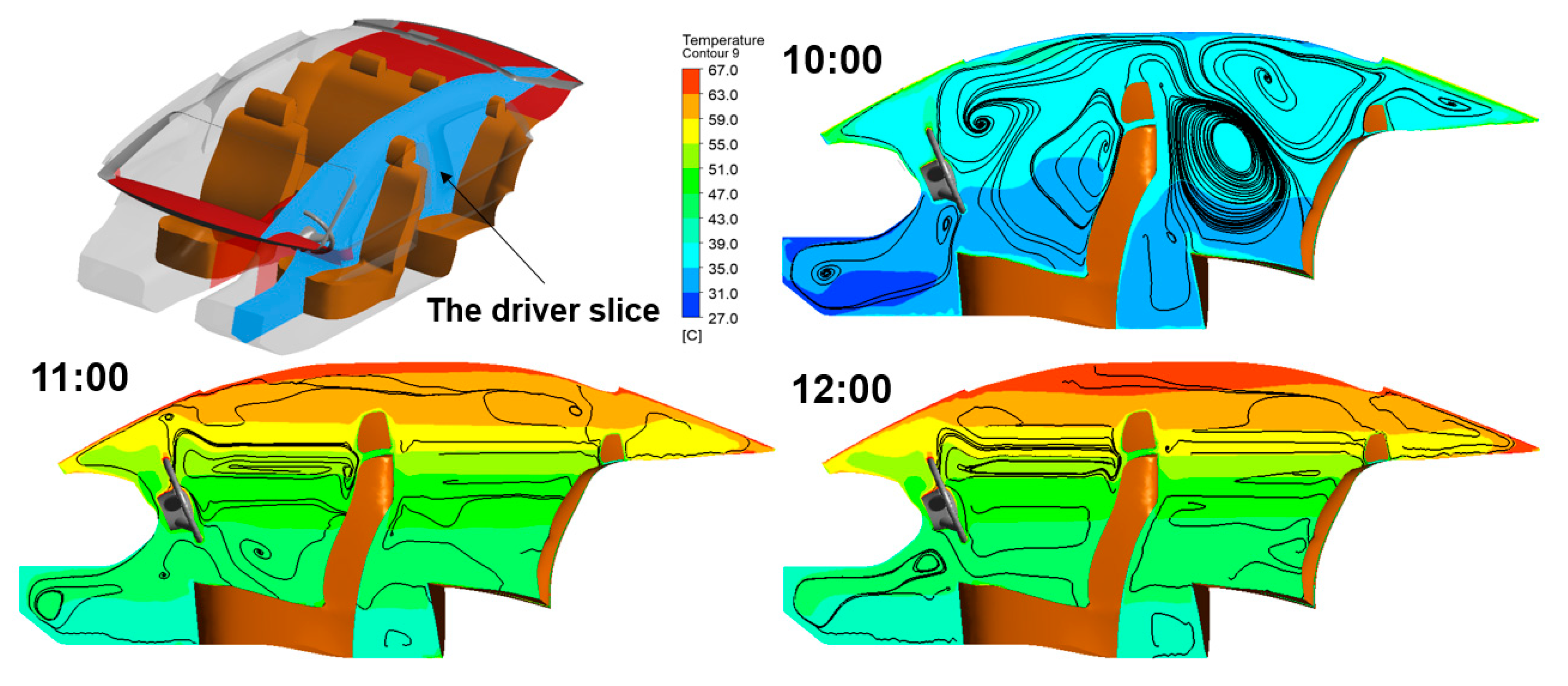
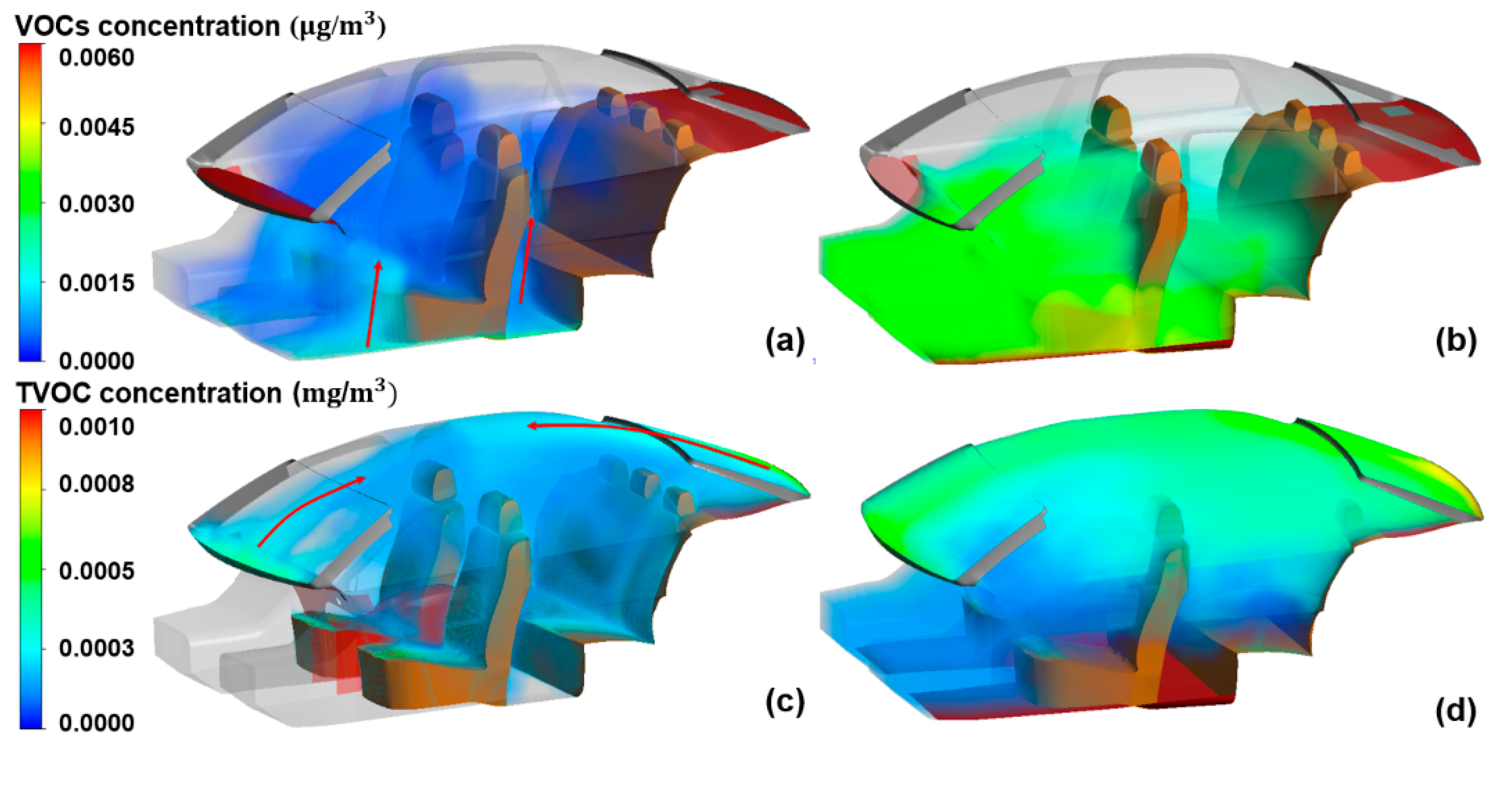
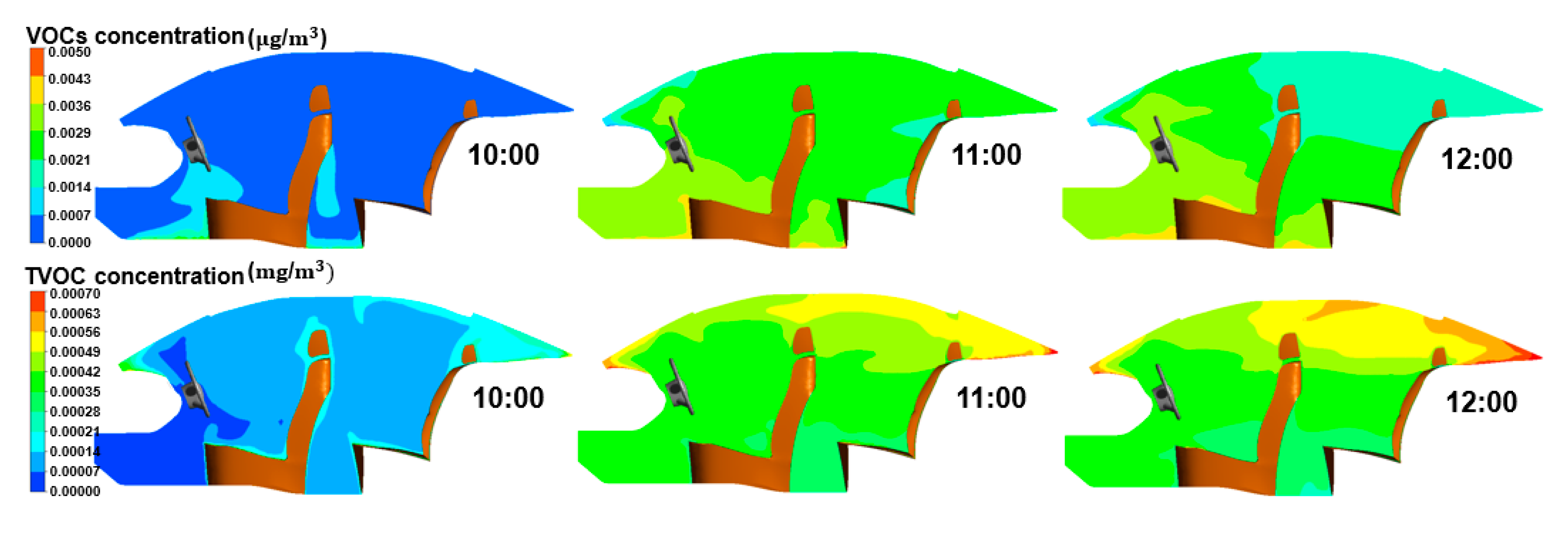
| Type | Cell Number | The Temperature of Point 18 (K) |
|---|---|---|
| Grid 1 | 5640 | 378.39 |
| Grid 2 | 9728 | 378.62 |
| Grid 3 | 35685 | 381.75 |
| Grid 4 | 108547 | 382.31 |
| Grid 5 | 207100 | 382.34 |
| Type | ER at 25 °C | ER at 35 °C | ER at 50 °C | |||
|---|---|---|---|---|---|---|
| VOCs | Benzene | 1.049 | 1.517 | 2.472 | ||
| Toluene | 2.472 | 0.595 | 1.376 | |||
| P-xylene | 0.423 | 0.517 | 0.659 | |||
| Ethylbenzene | 0.235 | 0.315 | 0.459 | |||
| Styrene | 0.447 | 0.517 | 0.635 | |||
| TVOC | ER at 35°C | ER at 50 °C | ER at 70 °C | ER at 80 °C | ER at 90 °C | |
| 0.393 | 1.836 | 4.459 | 6.033 | 9.311 | ||
| Parts | Dimension | Unit |
|---|---|---|
| body | 3100*1600*1230 | (L*W*H)(mm) |
| windshield | 0.864 | |
| rear window | 0.787 | |
| side window 1 and 3 | 0.224 | |
| side window 2 and 4 | 0.266 | |
| cabin volume | 2.716 |
| Parts | Material | Density | Thermal Conductivity | Specific Heat | Thickness δ/mm |
|---|---|---|---|---|---|
| vehicle body | steel | 8030.00 | 100.04 | 448.83 | 5.00 |
| Dashboard rear board | PBS | 1260.00 | 2.70 | 1480.60 | 5.00 |
| center console | 1.50 | ||||
| seats | 15.00 | ||||
| floor | carpet | 1601.85 | 0.29 | 1485.38 | 5.00 |
| windows | glass | 2529.58 | 1.17 | 754.04 | 5.00 |
| Surfaces | Absorptivity | Transmissivity | Diffuse hemispherical | |||
|---|---|---|---|---|---|---|
| Visible | Infra-red | Visible | Infra-red | Absorptivity | Transmissivity | |
| vehicle body | 0.7 | 0.1 | — | — | — | — |
| dashboard | 0.7 | 0.1 | — | — | — | — |
| rear board | 0.7 | 0.1 | — | — | — | — |
| center console | 0.7 | 0.1 | — | — | — | — |
| door | 0.7 | 0.1 | — | — | — | — |
| roof | 0.7 | 0.1 | — | — | — | — |
| seats | 0.8 | 0.1 | — | — | — | — |
| floor | 0.8 | 0.2 | — | — | — | — |
| windows | 0.14 | 0.65 | 0.76 | 0.25 | 0.1 | 0.5 |
| Parts | Area (m2) | Pollutants Mass |
|---|---|---|
| floor | 1.23 | 35.08 μg |
| dashboard | 0.39 | 1.94 mg |
| rear board | 0.68 | 3.40 mg |
| bucket seat 1 | 1.69 | 3.98 mg |
| bucket seat 2 | 1.69 | 3.80 mg |
| bench seat | 2.50 | 5.86 mg |
© 2020 by the authors. Licensee MDPI, Basel, Switzerland. This article is an open access article distributed under the terms and conditions of the Creative Commons Attribution (CC BY) license (http://creativecommons.org/licenses/by/4.0/).
Share and Cite
Tong, Z.; Liu, H. Modeling In-Vehicle VOCs Distribution from Cabin Interior Surfaces under Solar Radiation. Sustainability 2020, 12, 5526. https://doi.org/10.3390/su12145526
Tong Z, Liu H. Modeling In-Vehicle VOCs Distribution from Cabin Interior Surfaces under Solar Radiation. Sustainability. 2020; 12(14):5526. https://doi.org/10.3390/su12145526
Chicago/Turabian StyleTong, Zheming, and Hao Liu. 2020. "Modeling In-Vehicle VOCs Distribution from Cabin Interior Surfaces under Solar Radiation" Sustainability 12, no. 14: 5526. https://doi.org/10.3390/su12145526
APA StyleTong, Z., & Liu, H. (2020). Modeling In-Vehicle VOCs Distribution from Cabin Interior Surfaces under Solar Radiation. Sustainability, 12(14), 5526. https://doi.org/10.3390/su12145526





